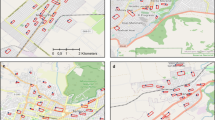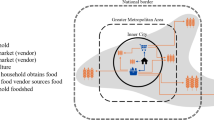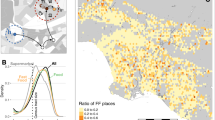Abstract
Objectives
Community food environment is closely associated with residents’ health status, and it has received substantial research attention in recent years. However, such studies are sparse in China. This study aims to reveal the characteristics of food environment in China.
Subjects
A ground-truthing field census of food outlets was conducted in Xi Hu district, Hangzhou. A novel categorizing system was developed to better characterize food outlets in the study area. Geocoding and food environment analysis were performed by Arc-GIS software.
Results
A total of 9274 food outlets were identified, of these, 6161 (66.43%) were food service places and 3113 (33.57%) were food stores. Fast-food restaurants (2692) and convenience stores (1764) were the two most numerous outlet types. The density of food outlets was 29.72/km2 and 113.97/10,000 people. Availability of BMI-unhealthy food outlets was four times greater than that of BMI-healthy ones. Further, 41.86% of total food outlets provided food-delivery services; among them, fast-food restaurants were the highest (65.53%) providers. In the urban area, the average density of food outlets was 104/km2. While, it was only 29/km2 in the rural area.
Conclusions
Availability of food outlets was excellent in our study area, though it showed regional imbalance. Food environment tends to be obesogenic and high prevalence of food delivery service might increase this trend. Thus, policy makers should guarantee the smooth development of catering industry in China, so as to ensure a balanced nutrition environment.
This is a preview of subscription content, access via your institution
Access options
Subscribe to this journal
Receive 12 print issues and online access
$259.00 per year
only $21.58 per issue
Buy this article
- Purchase on Springer Link
- Instant access to full article PDF
Prices may be subject to local taxes which are calculated during checkout




Similar content being viewed by others
References
Haslam DW, James WPT. Obesity. Lancet 2005;366:1197.
Chrostowska M, Szyndler A, Hoffmann M, Narkiewicz K. Impact of obesity on cardiovascular health. Best Pr Res Clin Endocrinol Metab 2013;27:147–56.
World Health Organization. Facts about overweight and obesity. 2018. http://media.centre/fact.sheets/fs311/en.
The World Health Organization. Prevalence of obesity among adults, BMI ≥ 25, crude estimates by country. 2017. http://apps.who.int/gho/data/node.main.A897A?lang=en.
The World Health Organization. Prevalence of obesity among adults, BMI ≥ 25, crude estimates by country. 2017. http://apps.who.int/gho/data/node.main.A900A?lang=en.
Du P, Zhang B, Wang HJ, Qi SF, Mi YJ, Yao JC, et al. The prevalence and secular trends of abdominal obesity among Chinese adults, 1993–2011. Ann Epidemiol 2015;25:797–9.
Du P, Wang HJ, Zhang B, Qi SF, Mi YJ, Liu DW, et al. Prevalence of abdominal obesity among Chinese adults in 2011. J Epidemiol 2017;27:282–6.
Hill JO, Peters JC. Environmental contributions to the obesity epidemic. Science. 1998;280:1371–4.
Steeves EA, Martins PA, Gittelsohn J. Changing the food environment for obesity prevention: key gaps and future directions. Curr Obes Rep 2014;3:451–8.
Gamba RJ, Schuchter J, Rutt C, Seto EY. Measuring the food environment and its effects on obesity in the United States: a systematic review of methods and results. J Community Health 2015;40:1–12.
Gordon C, Purciel-Hill M, Ghai NR, Kaufman L, Graham R, Van WG. Measuring food deserts in New York city’s low-income neighborhoods. Health Place 2011;17:696–700.
Simon H, Karen M, Jason C, Sisira S. G. Association between neighborhood fast food and full-service restaurant density and body mass index: a cross-sectional study of Canadian adults. Can J Public Health 2014;105:172–8.
Gordonlarsen P. Food availability/convenience and obesity. Adv Nutr 2014;5:809.
Zhang X, van der Lans, Dagevos H. Impacts of fast food and the food retail environment on overweight and obesity in China: a multilevel latent class cluster approach. Public Health Nutr 2012;15:88–96.
Hua J, Seto E, Li Y, Wang MC. Development and evaluation of a food environment survey in three urban environments of Kunming, China. BMC Public Health. 2014;14:1–18.
Powell LM, Auld MC, Chaloupka FJ, O’Malley PM, Johnston LD. Associations between access to food stores and adolescent body mass index. Am J Prev Med. 2007;33:S301–7.
Bodor JN, Rice JC, Farley TA, Swalm CM, Rose D. The association between obesity and urban food environments. J Urban Health. 2010;87:771–81.
Morland K, Diez Roux AV, Wing S. Supermarkets, other food stores, and obesity: the Atherosclerosis Risk in communities study. Am J Prev Med 2006;30:333–9.
Wang Y, Wang L, Xue H, Qu W. A review of the growth of the fast food industry in china and its potential impact on obesity. Int J Environ Res Public Health 2016;13:1112.
Xue H, Cheng X, Zhang Q, Wang HJ, Zhang B, Qu WD, et al. Temporal growth and spatial distribution of the fast food industry and its relationship with economic development in China 2005-12. Prev Med 2017;102:79–85.
Larson NI, Story MT, Nelson MC. Neighborhood environments: disparities in access to healthy foods in the U.S. Am J Prev Med 2009;36:74–81.
Boone-Heinonen J, Gordon-Larsen P, Kiefe CI, Shikany JM, Lewis CE, Popkin BM. Fast food restaurants and food stores: longitudinal associations with diet in young to middle-aged adults: the CARDIA study. Arch Intern Med 2011;171:1162–70.
Ho S, Wong B, Lo W, Mak K, Thomas G, Lam T, et al. Neighbourhood food environment and dietary intakes in adolescents: sex and perceived family affluence as moderators. Pedia Obes 2010;5:420–7.
Wansink B, Painter JE, Lee YK. The office candy dish: proximity’s influence on estimated and actual consumption. Int J Obes 2006;30:871–5.
Shu L, Zheng PF, Zhang XY, Si CJ, Yu XL, Gao W, et al. Association between dietary patterns and the indicators of obesity among Chinese: a cross-sectional study. Nutrients 2015;7:7995–8009.
Li M, Dibley MJ, Sibbritt DW, Yan H. Dietary habits and overweight/obesity in adolescents in Xi’an City, China. Asia Pac J Clin Nutr 2010;19:76–82.
Du W, Su C, Wang H, Wang Z, Wang Y, Zhang B. Is density of neighborhood restaurants associated with BMI in rural Chinese adults? A longitudinal study from the China health and nutrition survey. BMJ Open 2014;4:e004528.
Tian X, Zhong L, Von CS, Tu H, Wang H. Restaurants in the neighborhood, eating away from home and BMI in China. PLoS ONE 2016;11:e0167721.
Maimaiti M, Zhao X, Jia M, Ru Y, Zhu S. How we eat determines what we become: opportunities and challenges brought by food delivery industry in a changing world in China. Eur J Clin Nutr 2018;72:1282.
Bader MD, Ailshire JA, Morenoff JD, House JS. Measurement of the local food environment:a comparison of existing data sources. Am J Epidemiol 2010;171:609–17.
Liese AD, Barnes TL, Lamichhane AP, Hibbert JD, Colabianchi N, Lawson AB. Characterizing the food retail environment: impact of count, type, and geospatial error in two secondary data sources. J Nutr Educ Behav 2013;45:435–42.
Hangzhou Year Book. Major indicators of national economy (main years). 2017. http://tjj.hangzhou.gov.cn/tjnj/nj2017/index.htm.
National Bureau of Statistics of China. Gross Domestic Product of major cities in China from 2012 to 2016. 2017. http://data.stats.gov.cn/easyquery.htm?cn=E0105.
Bureau of Statistics of Hangzhou. Gross Domestic Product by region in Hangzhou from 2005 to 2016. 2017. http://tjj.hangzhou.gov.cn/tjnj/nj2017/index.htm.
Hangzhou Government. 2016. Xihu District: plan a new chapter for the 13th five-year plan. http://www.hangzhou.gov.cn/art/2016/1/7/art_812262_349743.html.
Glanz K, Sallis JF, Saelens BE, Frank LD. Nutrition environment measures survey in stores (NEMS-S): development and evaluation. Am J Prev Med 2007;32:282–9.
Saelens BE, Glanz K, Sallis JF, Frank LD. Nutrition environment measures study in restaurants (NEMS-R): development and evaluation. Am J Prev Med 2007;32:273–81.
Rundle A, Neckerman KM, Freeman L, Lovasi GS, Purciel M, Quinn J, et al. Neighborhood food environment and walkability predict obesity in New York City. Environ Health Perspect 2009;117:442–7.
Bouchard DR, Ross R, Janssen I. Coffee, tea and their additives: association with BMI and waist circumference. Obes Facts 2010;3:345–52.
Xu H, Short SE, Liu T. Dynamic relations between fast-food restaurant and body weight status: a longitudinal and multilevel analysis of Chinese adults. J Epidemiol Community Health 2013;67:271.
Duffey KJ, Gordon-Larsen P, Jacobs DR, Williams OD, Popkin BM. Differential associations of fast food and restaurant food consumption with 3-y change in body mass index: the coronary artery risk development in young adults study. Am J Clin Nutr 2007;85:201–8.
Chinese Nutrition Society. The chinese dietary guidelines. 4th ed. Beijing: Chinese Nutrition Society; 2016. http://dg.cnsoc.org/.
Larson N, Story M. A review of environmental influences on food choices. Ann Behav Med 2009;38:S56.
Rahmanian E, Gasevic D, Vukmirovich I, Lear SA. The association between the built environment and dietary intake—a systematic review. Asia Pac J Clin Nutr 2014;23:183–96.
Daniel M, Yan K, Paquet C. Demographic and urban form correlates of healthful and unhealthful food availability in Montréal, Canada. Can J Public Health 2009;100:189–93.
Pessoa MC, Mendes LL, Gomes CS, Martins PA, Velasquezmelendez G. Food environment and fruit and vegetable intake in a urban population: a multilevel analysis. BMC Public Health 2015;15:1–8.
Anderson B, Rafferty AP, Lyon-Callo S, Fussman C, Imes G. Fast food consumption and obesity among Michigan adults. Prev Chronic Dis 2011;8:A71.
Fraser LK, Clarke GP, Cade JE, Edwards KL. Fast food and obesity: a spatial analysis in a large United Kingdom population of children aged 13–15. Am J Prev Med 2012;42:e77–85.
De Vogli R, Kouvonen A, Gimeno D. The influence of market deregulation on fast food consumption and body mass index: a cross-national time series analysis. Bull World Health Organ 2014;92:99–107.
Min J, Zhao YL, Slivka L, Wang YF. Double burden of diseases worldwide: coexistence of undernutrition and overnutrition-related non-communicable chronic diseases. Obes Rev 2018;19:49–61.
Jiang Y, Su X, Wang C, Zhang L, Zhang X, Wang L, et al. Prevalence and risk factors for stunting and severe stunting among children under three years old in mid-western rural areas of China. Child Care Health Dev 2015;41:45–51.
Nahar S, Grover K, Chawla P. Nutritional status of rural school children in central zone of Punjab. J Res Punjab Agric Univ 2009;46:94–8.1 and 2.
Sonnino R, Marsden T. Beyond the divide: rethinking relationships between alternative and conventional food networks in Europe. Soc Sci Electron Publ 2006;6:181–99.
Jennifer F, Nadia R, Grummon AH, Madsen KA. Higher retail prices of sugar-sweetened beverages 3 months after implementation of an excise tax in Berkeley, California. Am J Public Health 2015;105:2194–201.
Restrepo BJ, Ali MM. Restaurant menu labeling laws and alcohol use. Prev Med 2017;102:65.
Mah CL, Timmings C. Equity in public health ethics: the case of menu labelling policy at the local level. Public Health Ethics. 2015;8:85–9.
Solomon S, Mallya G, Aquilante J, Sandoval BA, Karpyn A. Healthy corner stores: successful models for increasing healthy food access. J Acad Nutr Diet 2012;112:A71.
Acknowledgements
The authors wish to acknowledge the grants of China Medical Board (14–197 and 15–216) and Cyrus Tang Foundation (419600-11102) for the support of current work.
Author information
Authors and Affiliations
Corresponding author
Ethics declarations
Conflict of interest
The authors declare that they have no conflict of interest.
Additional information
Publisher’s note: Springer Nature remains neutral with regard to jurisdictional claims in published maps and institutional affiliations.
Supplementary information
Rights and permissions
About this article
Cite this article
Maimaiti, M., Ma, X., Zhao, X. et al. Multiplicity and complexity of food environment in China: full-scale field census of food outlets in a typical district. Eur J Clin Nutr 74, 397–408 (2020). https://doi.org/10.1038/s41430-019-0462-5
Received:
Revised:
Accepted:
Published:
Issue Date:
DOI: https://doi.org/10.1038/s41430-019-0462-5
This article is cited by
-
Towards social life cycle assessment of food delivery: findings from the Italian case study
The International Journal of Life Cycle Assessment (2024)
-
Investigating experiences of frequent online food delivery service use: a qualitative study in UK adults
BMC Public Health (2022)
-
Type, density, and healthiness of food-outlets in a university foodscape: a geographical mapping and characterisation of food resources in a Ghanaian university campus
BMC Public Health (2022)
-
A cross-sectional comparison of meal delivery options in three international cities
European Journal of Clinical Nutrition (2020)



